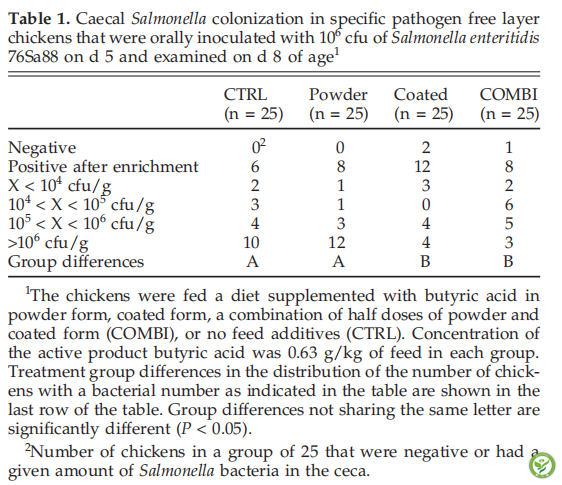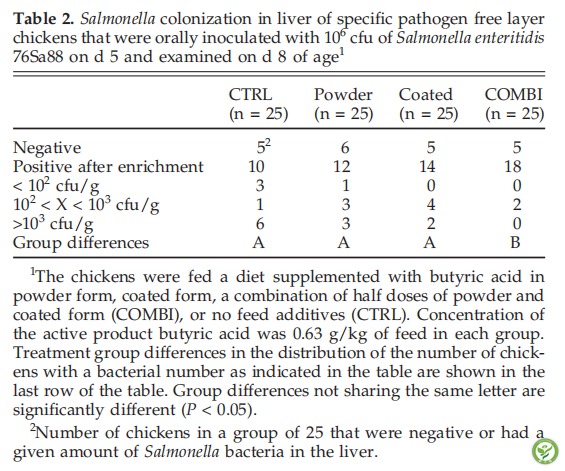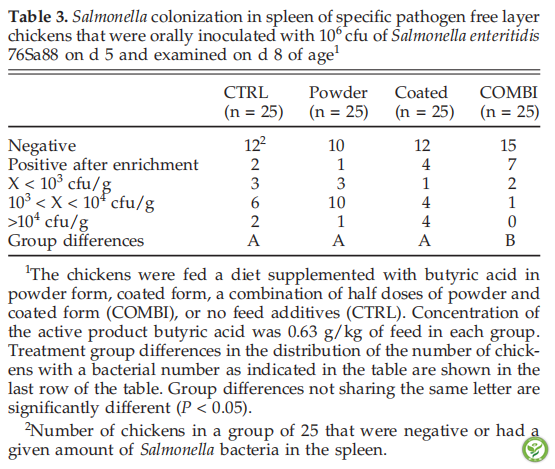第68期:丁酸减少家禽沙门氏菌-盲肠定植和粪便脱落
原标题:日粮添加微囊化包被的丁酸可减少沙门氏菌在家禽中的定殖和脱落
Supplementation of Coated Butyric Acid in the Feed Reduces Colonization and Shedding of Salmonella in Poultry
作者:F. Van Immerseel,1 F. Boyen, I. Gantois, L. Timbermont, L. Bohez, F. Pasmans,
F. Haesebrouck, and R. Ducatelle
Department of Pathology, Bacteriology and Avian Diseases, Research Group Veterinary Public Health and Zoonoses, Faculty
of Veterinary Medicine, Ghent University, Salisburylaan 133, B-9820 Merelbeke, Belgium
来源:2005 Poultry Science 84:1851-1856 doi:10.1093/ps/84.12.1851
翻译:肠动力研究院 梁琦
【摘要】短链脂肪酸(SCFAs)已被广泛用作饲料添加剂以控制家禽中的沙门氏菌。 但目前关于丁酸在家禽上的应用研究非常少。本文旨在通过两个试验来探究粉末形式和微囊化包被形式的丁酸对肠炎沙门氏菌感染雏鸡后,降低沙门氏菌在盲肠和内脏器官定植能力的影响。
试验一:100羽刚孵化的SPF罗曼白鸡被随机分成4个处理组,试验分组如下,1)CTRL组:饲喂基础日粮;2)Power组:喂食基础日粮+0.63g/kg粉末状丁酸(含有98%正丁酸钠盐的白色或灰白色粉末);3)Coated组:饲喂基础日粮+2.5g/kg微囊化包被的丁酸(含有30%正丁酸钠盐);4)COMBI组:喂食基础日粮+0.315g/kg粉末状丁酸+1.25g/kg包被的丁酸。每组25羽,同时保证前三组添加的丁酸含量(0.63g/kg)相同。所有SPF蛋鸡在第5天口服接种106cfu 76Sa88型肠炎沙门氏菌,第6天检测所有蛋鸡的泄殖腔试子,第8天将所有蛋鸡安乐死并收集盲肠,肝脏和脾脏样品进行细菌学分析。
实验二:100羽1日龄Ross肉鸡被随机分配成2个处理组,每组50羽。试验分组如下,1)CTRL组:第0-10天喂食以小麦为主的基础日粮,之后转为肉鸡日粮;2)Coated组:饲喂基础日粮+2.5g/kg微囊化包被的丁酸。孵化后的第5天,从两组肉鸡中分别随机选取10只口服接种105cfu 76Sa88型肠炎沙门氏菌,之后与其余40只未感染的肉鸡进行混合饲养。分别在第6,9,13,20,27,34和41天,采集所有肉鸡的泄殖腔拭子并进行细菌学分析。第42天通过静脉内注射T61致死所有肉鸡并采集盲肠样品进行细菌学分析。
实验一结果显示,与对照组蛋鸡相比,日粮添加微囊化包被的丁酸在肠炎沙门氏菌感染后3天可显著降其在盲肠的定植,而日粮添加粉末状丁酸的蛋鸡则没有效果。实验二结果显示,日粮添加微胶囊化包被的丁酸可显著降低沙门氏菌脱落的肉鸡数量,但在致死时盲肠中定植的细菌计数对两组来说都是相同的。总的来说,在感染后不久丁酸可减少肠炎沙门氏菌在盲肠的定植,同时降低粪便中脱落的数量,从而进一步减少被肠炎沙门氏菌感染的肉鸡对环境的污染。然而,要想完全消除感染只能通过采取卫生措施和不同保护措施的组合方法来实现,因为肉鸡在致死时仍可能在盲肠中携带一定量的肠炎沙门氏菌,尽管处在一个比较低的水平。
【关键词】丁酸;肠炎沙门氏菌;肉鸡;脱落
以下是相关图表
表1:试验第5天和第8天,口服106cfu 76Sa88型肠炎沙门氏菌的SPF蛋鸡的盲肠沙门氏菌计数

表2:试验第5天和第8天,口服106cfu 76Sa88型肠炎沙门氏菌的SPF蛋鸡的肝脏沙门氏菌计数

表3:试验第5天和第8天,口服106cfu 76Sa88型肠炎沙门氏菌的SPF蛋鸡的脾脏沙门氏菌计数

表4:直接接种于亮绿色琼脂培养基上后,沙门氏菌阳性拭子的比例显示随时间(日龄)的变化(上图),浓缩后阳性拭子的比例(下图)。使用播种机模型进行感染。孵化后第5天通过口服接种105cfu 76Sa88的肠炎沙门氏菌的10只Ross肉鸡。然后将感染的肉鸡与40只未接种的肉鸡一起饲养。给肉鸡喂食添加有微囊化包被的丁酸(0.63g/kg丁酸)的日粮(¨)和基础日粮(●)。*各组之间存在显著性差异(P <0.05;n = 50)。

结论
总之,丁酸可减少粪便中沙门氏菌的脱落,从而进一步降低被肠炎沙门氏菌感染的肉鸡对环境的污染。然而,完全消除可能只能通过使用卫生措施和不同保护措施的组合方法来实现。
ABSTRACT
Short-chain fatty acids have been widely used as feed additives to control Salmonella in poultry. Data on the use of butyric acid in poultry are lacking. In this study, powder form and coated butyric acid were compared in their ability to reduce Salmonella colonization of ceca and internal organs shortly after infection of young chickens with Salmonella enteritidis. In the fifirst trial, 4 groups of 25 specifific pathogen free layer chickens were given feed either supplemented with powder form butyric acid, coated butyric acid, a combination of powder form and coated butyric acid (all groups received a total of 0.63 g of butyric acid/kg) or nonsupplemented feed. The specifific pathogen free layer chickens were orally infected with 106 cfu of S. enteritidis. Coated butyric acid signifificantly decreased cecal colonization 3 d post-infection compared with control chickens, and powder form butyric acid had no effect. To study long-term shedding and colonization of Salmonella in broilers given coated butyric acid as feed additive (0.63 g of active product butyric acid/kg), 10 Ross broiler chickens were infected at d 5 with 105 cfu of S. enteritidis and housed together
with 40 noninfected broilers. A control group received nonsupplemented feed. The group of broilers receiving coated butyric acid had a signifificantly lower number of
broilers shedding Salmonella bacteria, but cecal colonization at slaughter age was equal for both groups. In conclusion, butyric acid decreases cecal colonization shortly
after infection, decreases fecal shedding, and as a consequence, decreases environmental contamination by S. enteritidis-infected broilers. However, complete elimination can probably only be achieved with a combined approach using both hygienic measures and different protection measures, as the broilers still carried S. enteritidis bacteria in the ceca at slaughter age, although at enrichment level.
Key words: butyric acid, Salmonella enteritidis, broiler, shedding
Conclusion
In conclusion, butyric acid can be used to decrease fecal shedding of Salmonella and, as a consequence, environmental contamination of Salmonella in S. enteritidis-infected broilers. However, complete elimination can probably only be achieved with a combined approach using both hygienic measures and different protection measures
如您需原文,请联系本文作者和出版方,或请垂询肠动力研究院。本网站发布的所有资料将尽最大可能注明出处、作者及日期,如无意中侵犯了您的知识产权,请来信及时告知,我们将立即予以删除。
All information released by the WeChat Official Account will do its best to indicate the source, author and date. If we inadvertently infringe on your intellectual property, please inform us in time and we will delete it immediately.



